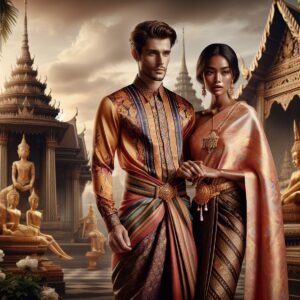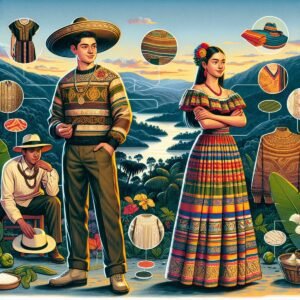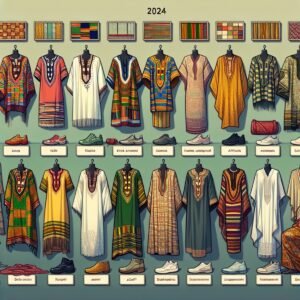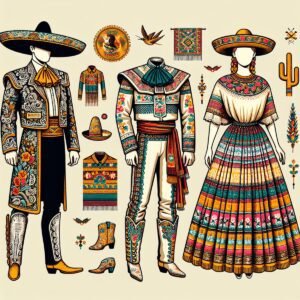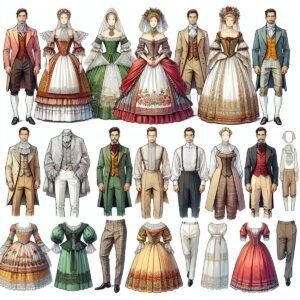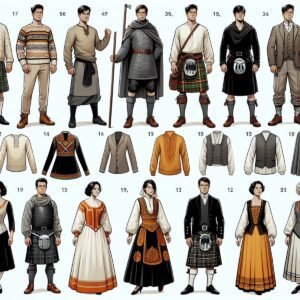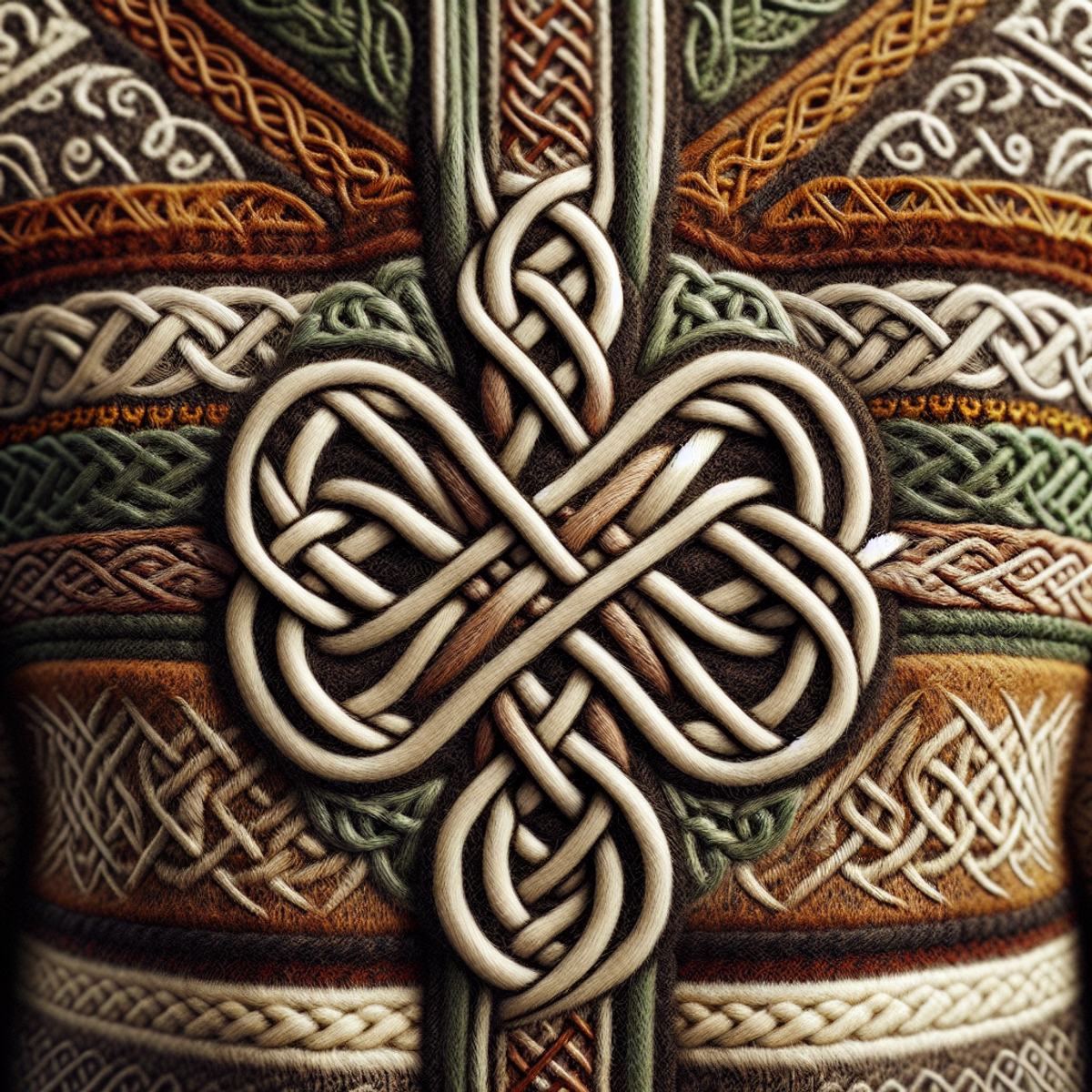
1. Introduction
Traditional Irish clothing is an important part of Irish culture and heritage. It represents the history, traditions, and identity of the country. These clothes are carefully made with intricate designs, meaningful patterns, and Celtic symbols.
Materials Used in Traditional Irish Clothing
The materials commonly used in traditional Irish clothing are:
- Wool
- Linen
- Leather
These fabrics not only make the garments long-lasting but also connect them to Ireland’s natural environment. They are often decorated with detailed embroidery or lacework, showcasing the skill and creativity involved in making them.
Symbolism in Traditional Irish Clothing
The designs and patterns found in traditional Irish clothing have deep meanings attached to them. Some common symbols include:
- Celtic knots: These knots, with their interwoven lines, represent eternity and the interconnectedness of life.
- Triskelion: A triple spiral symbolizing the elements of land, sea, and sky.
These symbols add layers of significance to the garments.
Everyday Attire with Regional Variations
Traditional Irish clothing was not just worn for special occasions but also as everyday clothing. Each region in Ireland had its own unique style and variations, highlighting the diverse range within the country’s fashion heritage.
In this article, we will explore:
- The ancient origins and historical importance of traditional Irish clothing
- Specific types of clothing for both men and women
- The craftsmanship behind the designs
- How traditional dress has changed over time while still maintaining its cultural essence
- Where to find authentic pieces and how to incorporate them into modern outfits
2. Ancient Origins and Historical Significance

The history of traditional Irish clothing can be traced back to the ancient Celtic period. During this time, the Celts, who were an ancient group that lived in Ireland, had a strong influence on the early styles of Irish clothing. They were known for their unique designs and their use of natural materials like wool and linen.
Over time, the styles of Irish clothing evolved as different influences came into play. One significant influence was Christianity. When Christianity was introduced to Ireland, it brought with it new weaving techniques and the use of religious symbols in garments. This reflected a blending of pagan and Christian beliefs.
Despite external pressures such as English colonization, the monastic tradition played a crucial role in preserving and creating traditional Irish clothing. Monasteries became important centers for textile production, where skilled craftsmen would weave intricate designs into fabrics. This helped to protect the authenticity of Irish clothing from outside influences.
Traditional Irish clothing holds a lot of historical significance as it tells the story of Ireland’s past. It reflects the cultural changes and influences that have shaped the country over hundreds of years – from its ancient Celtic roots to the lasting impact of Christianity and its resistance against colonial rule.
3. Traditional Irish Clothing for Men and Women
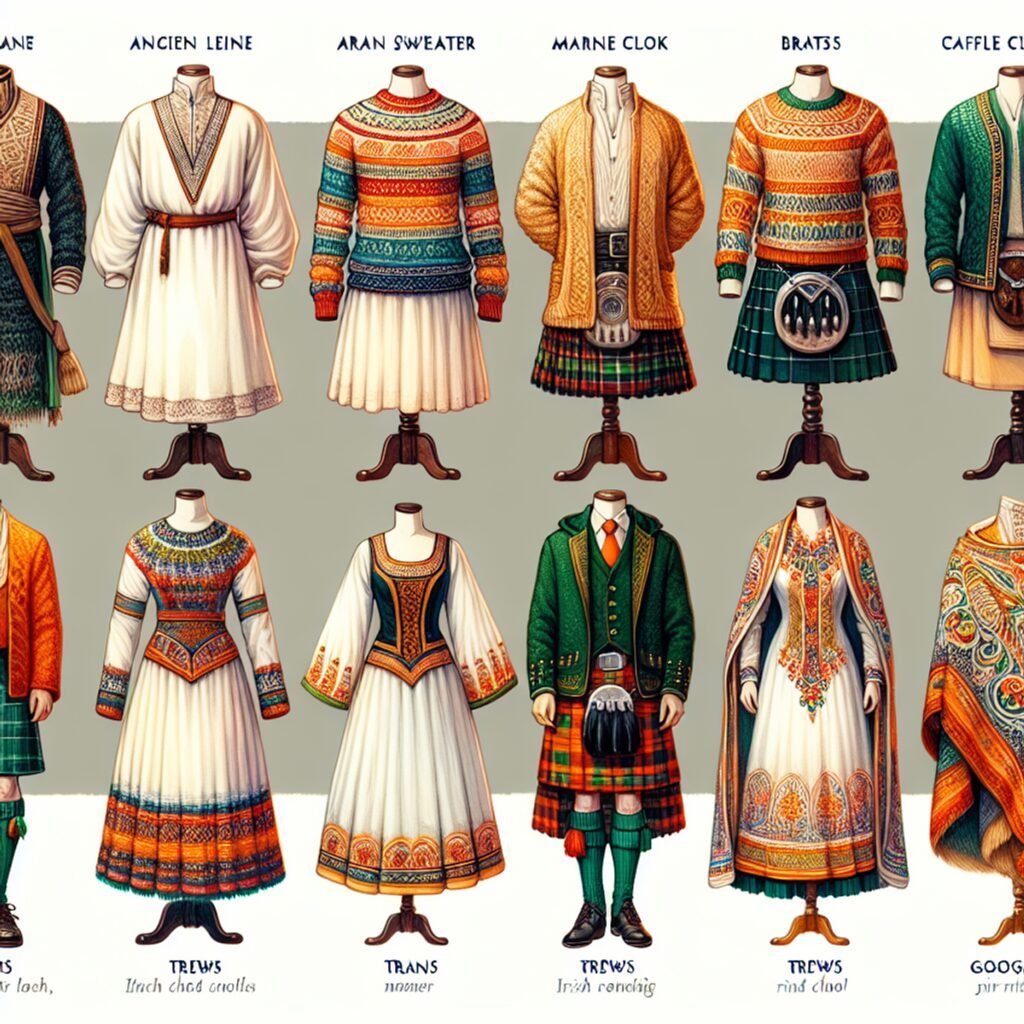
Traditional Irish clothing includes various unique clothes that both men and women have worn over the years. Here are some examples:
- Aran Sweaters: Aran sweaters are famous symbols of Irish heritage. They come from the Aran Islands on the west coast of Ireland and are known for their detailed stitch patterns and skilled craftsmanship. The stitches often represent things like hard work or fishing ropes. Aran sweaters aren’t just nice to look at – they’re also warm and protect you from bad weather.
- Step Dance Dresses: Step dance dresses are fancy outfits made for traditional Irish dances. They usually have bright colors and detailed designs that show the different styles in each region. The dresses fit tightly on top with a wide skirt that lets you move around easily during dances like the jig or reel. Every part of Ireland might have its own special design details, so step dance dresses are a way to see local traditions and culture.
- Grandfather Shirts: Grandfather shirts, also called “leáine chaorach” in Gaelic, are a classic part of men’s traditional clothing in Ireland. These shirts have a loose style, comfortable fabric (usually linen or cotton), and a unique grandad collar detail. You can wear them casually or dress them up for fancier events, so they’re versatile clothes that never go out of fashion.
- Irish Walking Hats: Irish walking hats bring together usefulness and style. They’re usually made of tweed or felt and were traditionally worn by both men and women during outdoor activities like hiking or working on farms. These hats keep you dry and warm when it’s rainy or windy outside while also adding a bit of Irish flair to your outfit.
The different kinds of traditional Irish clothing for men and women show off the amazing skills and history of Irish culture. Each piece of clothing tells its own story about Irish traditions and who the people are. So whether you want to connect with your Irish roots or just admire how beautiful these clothes are, traditional Irish clothing gives you a peek into the wonderful world of Irish history.
4. The Artistry of Design in Irish Garments
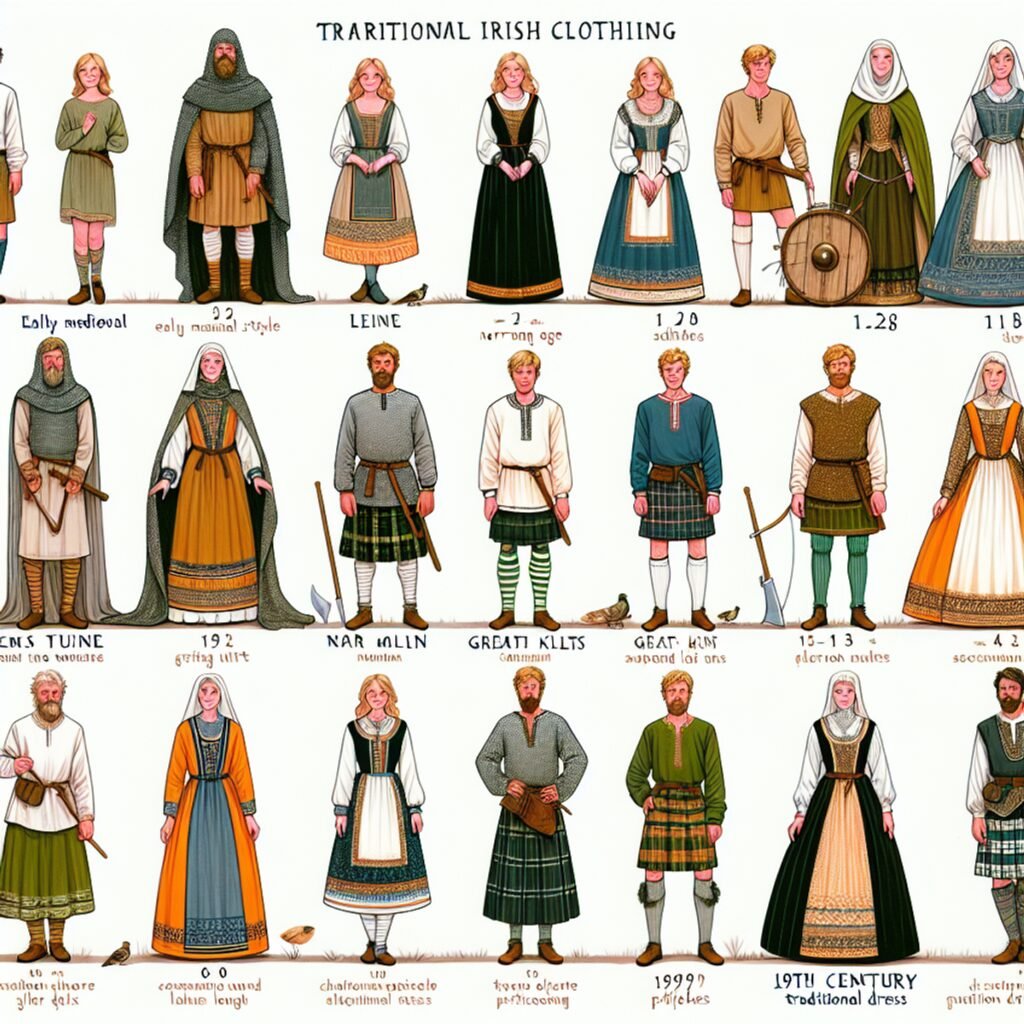
The intricate Celtic knotwork patterns found on traditional Irish clothing hold deep symbolism, representing eternity and interconnectedness. These captivating designs often feature interlacing lines, showcasing the skillful artistry and cultural significance of Irish attire.
Exploring Symbolism in Irish Garments
In addition to Celtic knotwork, there are other meaningful symbols embedded in Irish culture. One such symbol is the triskelion, characterized by its triple spiral formation. It signifies the unity of land, sea, and sky – an interconnected relationship cherished by the Celts.
Preserving Tradition Through Craftsmanship
Creating these elaborate designs requires meticulous attention to detail and craftsmanship techniques. Each knot and symbol is carefully constructed to honor the legacy and heritage associated with traditional Irish clothing, reflecting a profound reverence for history and culture.
5. Traditional Irish Attire: From Past to Present
Traditional Irish clothing has gracefully adapted to the demands of modern times, showcasing its resilience and timeless appeal. The evolution of traditional Irish attire reflects a harmonious balance between preserving cultural heritage and embracing contemporary influences.
Examples of contemporary interpretations and fusion with mainstream fashion
Contemporary Irish designers have skillfully incorporated elements of traditional clothing into modern fashion trends, creating a fusion that appeals to a global audience while honoring the rich legacy of Irish attire. From runway shows to everyday street style, traditional Irish garments have found new life through innovative designs and interpretations, ensuring their relevance in today’s fashion landscape.
6. Embracing Irish Identity Through Traditional Dressing
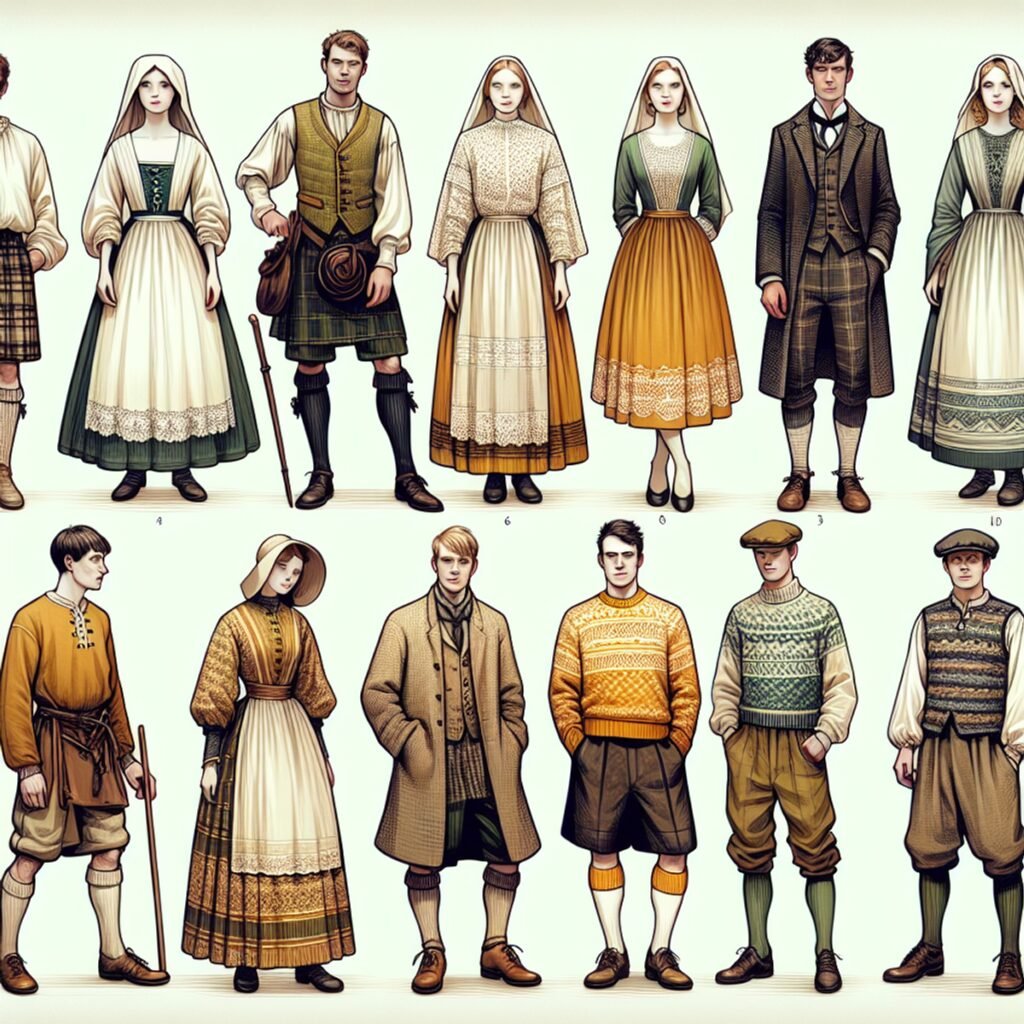
Traditional Irish clothing is deeply meaningful, serving as a way for people to connect with their heritage and proudly display their Irish identity. It goes beyond just wearing a costume; it’s a way of embracing one’s roots and honoring the traditions of the past.
The Significance of Traditional Irish Attire
- History: Each piece of traditional Irish clothing carries a story, reflecting the history and struggles of the Irish people.
- Symbolism: The designs and patterns found in these garments often hold symbolic meaning, representing elements of nature, spirituality, or folklore.
- Craftsmanship: Traditional Irish attire is known for its intricate craftsmanship, showcasing the skill and artistry passed down through generations.
Why Wear Traditional Irish Clothing?
By choosing to wear traditional Irish clothing, individuals can:
- Connect with Ireland: It serves as a visible link to Ireland, allowing individuals to proudly display their connection to the country.
- Celebrate Heritage: Wearing these garments is a way of celebrating one’s heritage and paying tribute to ancestors.
- Preserve Culture: By continuing to wear traditional attire, individuals help keep this aspect of Irish culture alive for future generations.
Beyond the Garments: Understanding and Engaging
Embracing Irish identity through traditional dressing involves more than just wearing the clothes themselves. It requires:
- Knowledge: Understanding the history and significance behind each piece of clothing, as explored in this research paper about traditional Irish attire.
- Appreciation: Recognizing the craftsmanship involved in creating these garments, which are often handmade using traditional techniques.
- Inclusion: Engaging in cultural events and celebrations where traditional Irish clothing is showcased, such as festivals or community gatherings that celebrate Irish heritage.
Through these actions, individuals can actively participate in their community, share stories, and forge connections with others who also value their Irish identity.
Resistance Against Homogenization
In a world dominated by global fashion trends, wearing traditional Irish attire can be seen as an act of resistance. It allows individuals to stand out, express their individuality, and embrace their roots in the face of homogenization.
Finding Authentic Traditional Irish Clothing
In the next section, we will explore where you can find authentic pieces of traditional Irish clothing today and how to incorporate them into your modern wardrobe while respecting their cultural significance.
7. Where to Find and How to Wear Traditional Irish Clothing Today
Traditional Irish clothing is not only a link to the past but also a way to celebrate Irish heritage and culture in the present. If you’re interested in incorporating traditional Irish clothing into your wardrobe, here are some tips on where to find authentic pieces and how to wear them with style and respect:
1. Sourcing Authentic Pieces
- Look for local artisans and specialized boutiques that specialize in traditional Irish clothing. These places often carry handcrafted garments made with high-quality materials and attention to detail.
- Attend craft fairs, cultural festivals, and events that feature traditional Irish clothing. Here, you can interact with artisans directly and learn about their craft.
- Consider purchasing from online platforms that support local Irish artisans and offer authentic traditional clothing options.
2. Appropriate Occasions and Styling Options
- Traditional Irish clothing can be worn for various occasions, from festive events to casual outings. For formal occasions, consider wearing a beautifully crafted Aran sweater or a step dance dress adorned with regional variations.
- Grandfather shirts are versatile pieces that can be worn casually or dressed up with accessories like suspenders or a waistcoat.
- Pair your traditional Irish garments with modern pieces to create a fusion of old and new styles. For example, wear an Aran sweater with jeans or layer a step dance dress with a leather jacket for a contemporary twist.
3. Respectful Appreciation
- When wearing traditional Irish clothing, it’s important to do so respectfully and without cultural appropriation. Educate yourself about the history, symbolism, and significance of the garments you choose to wear.
- Avoid caricaturing or stereotyping Irish culture through your choices of clothing. Instead, embrace the beauty and craftsmanship of traditional Irish attire as a way to honor the culture it represents.
- Engage with local communities and seek guidance from experts on appropriate styling and cultural etiquette to ensure you wear traditional Irish clothing with respect and appreciation.
By following these tips, you can authentically incorporate traditional Irish clothing into your wardrobe, paying homage to Irish heritage and culture while celebrating the timeless elegance of these garments.
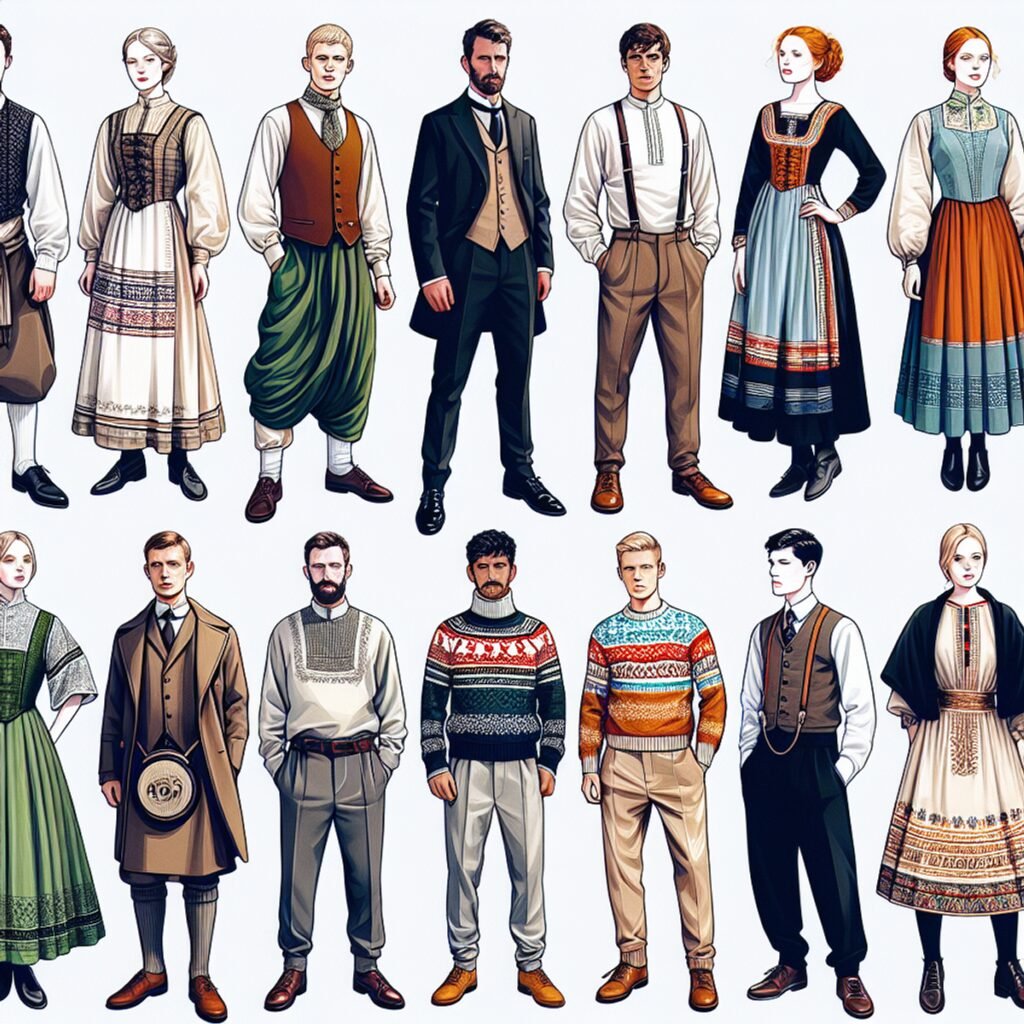
8. The Future of Traditional Irish Clothing: Keeping the Tradition Alive
It is crucial to support traditional craftsmanship and sustainable practices in the production of Irish garments in order to preserve the heritage of traditional Irish clothing. This means not only appreciating the skills and techniques passed down through generations but also making sure that these practices are environmentally friendly and morally upright. By embracing sustainable materials and production methods, we can help traditional Irish clothing last longer and align it with modern values of taking care of the environment and making ethical choices.
The Role of the Fashion Industry
The fashion industry plays a vital role in raising awareness about traditional clothing heritage and ensuring its preservation for future generations. Here’s how it can contribute:
- Collaboration: By working together with designers, artisans, and cultural institutions, the fashion industry can actively promote and exhibit traditional Irish clothing on an international scale.
- Exposure: Showcasing these one-of-a-kind garments through fashion shows, exhibitions, and media features brings them into the spotlight, giving people from all over the world a chance to appreciate their beauty and significance.
- Education: Through campaigns, workshops, and storytelling, the fashion industry can educate consumers about the history, craftsmanship, and cultural importance behind traditional Irish clothing.
Supporting Local Artisans and Producers
In addition to the involvement of the fashion industry, it is equally important to support local artisans and traditional garment producers directly. This can be done through various initiatives:
- Fair Trade Practices: Ensuring that artisans receive fair wages for their work and have safe working conditions.
- Market Access: Creating opportunities for small-scale producers to access wider markets both locally and internationally.
- Skills Development: Providing training programs and resources to empower artisans with new skills or enhance existing ones.
- Community Engagement: Encouraging community pride in traditional crafts by organizing events, festivals, and exhibitions that highlight their work.
By recognizing the value of traditional craftsmanship and leveraging the influence of the fashion industry, the future of traditional Irish clothing remains promising, ensuring its enduring presence in both local and global contexts.
9. In Conversation with Irish Fashion Designer: Balancing Tradition and Innovation
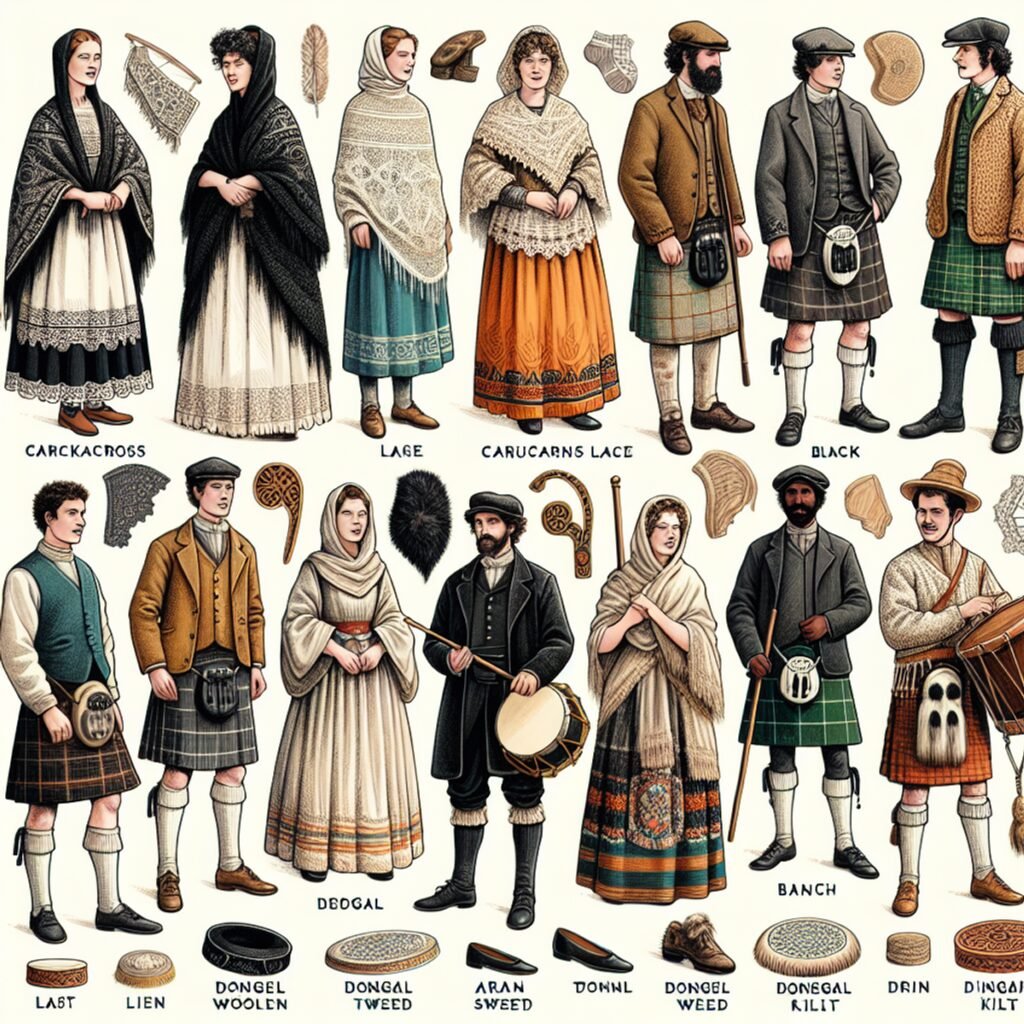
Exclusive Interview with Renowned Irish Fashion Designer
In our quest to explore the creative perspective behind blending traditional elements with contemporary aesthetics in Irish fashion, we had the honor of interviewing [Name], a highly acclaimed Irish fashion designer. Known for their innovative approach to design, [Name] has successfully struck a balance between tradition and innovation in their collections.
During the interview, [Name] shared their insights and experiences, shedding light on their unique design philosophy and the challenges they face when incorporating traditional Irish clothing into modern fashion. Here are some key highlights from our conversation:
- Honoring Cultural Heritage: [Name] emphasized the importance of understanding and respecting the cultural significance of traditional Irish clothing. They explained how they delve deep into historical research to ensure authenticity while infusing their own artistic vision.
- Contemporary Adaptations: [Name] expressed their passion for reinterpreting traditional designs through a modern lens. By experimenting with materials, silhouettes, and techniques, they create garments that resonate with a younger generation while preserving the essence of Irish heritage.
- Innovation through Collaboration: [Name] highlighted the collaborative nature of their work, often partnering with local artisans and craftsmen who specialize in traditional techniques. This collaboration not only ensures the preservation of traditional craftsmanship but also fosters a sense of community within the industry.
- Sustainability and Ethical Practices: [Name] emphasized their commitment to sustainable fashion practices. They actively seek out eco-friendly materials and promote ethical production methods, aiming to minimize environmental impact while supporting local communities.
- Global Influence: [Name] discussed how globalization has influenced their design process, allowing them to incorporate diverse cultural influences into their collections. They believe that by embracing these global perspectives, they can create unique pieces that celebrate both Irish heritage and the interconnectedness of cultures worldwide.
Through this enlightening conversation, we gained valuable insights into the intricate balance between tradition and innovation in Irish fashion. [Name]’s dedication to preserving and evolving traditional Irish clothing serves as an inspiration for designers and fashion enthusiasts alike.
10. Celebrating Diversity: Modern Interpretations of Traditional Irish Clothing from Different Regions
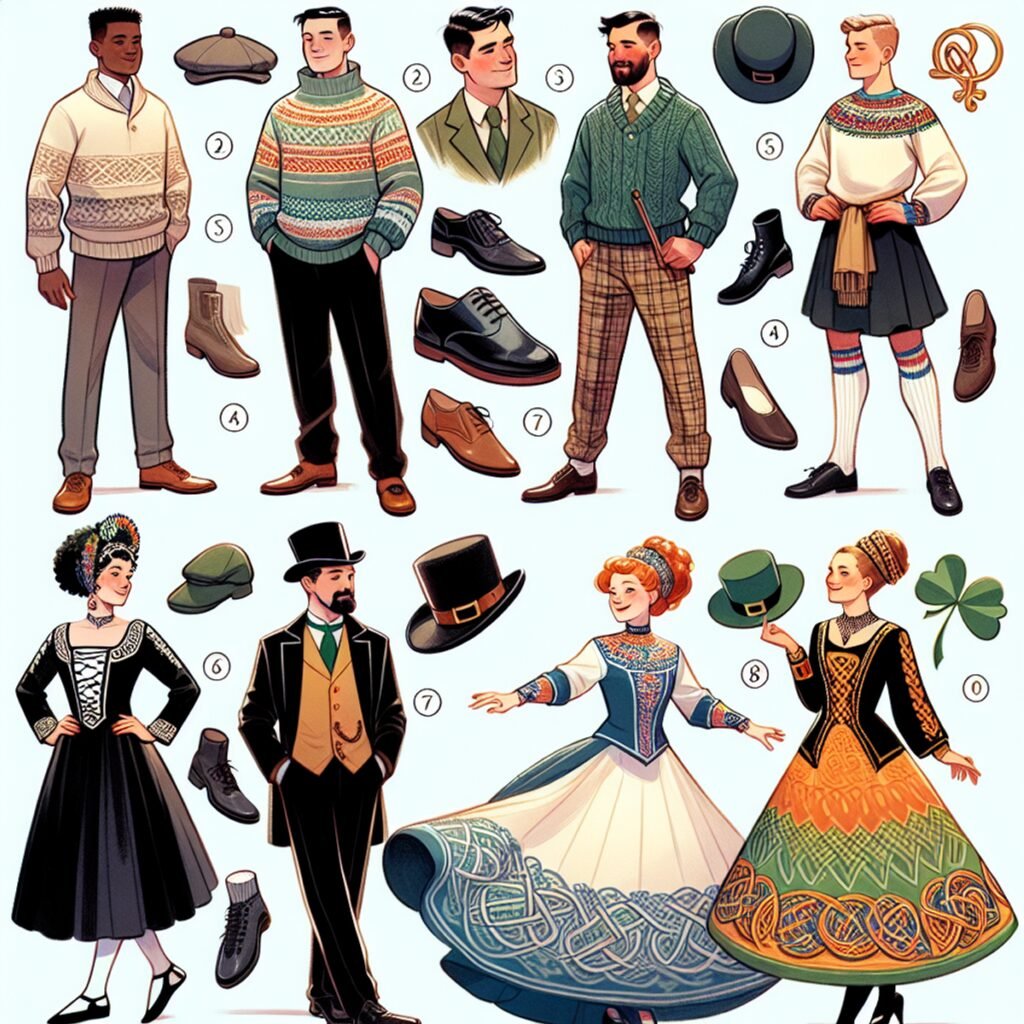
Traditional Irish clothing varies across different regions in Ireland, each with its unique styles and variations influenced by geographical and cultural factors.
Aran Islands: The Storytelling Sweaters
The Aran Islands, off the west coast of Ireland, are renowned for their distinctive Aran sweaters, featuring intricate cable and diamond patterns that reflect the islanders’ livelihoods and environment.
County Donegal: Weaving Tales with Tweed
In County Donegal, tweed fabrics are a prominent feature in traditional attire, with earthy tones and herringbone designs reflecting the rugged landscapes and weaving heritage of the region.
Connemara: Colors of Gaelic Heritage
The Connemara region is known for its vibrant and colorful woolen shawls, showcasing a blend of Gaelic tradition and natural beauty inspired by the surrounding landscapes.
County Kerry: Unveiling Celtic Roots
County Kerry’s rich history is reflected in its traditional clothing, with influences from ancient Celtic styles and ornate embellishments symbolizing the region’s cultural heritage.
The regional diversity of traditional Irish clothing offers a fascinating insight into the country’s heritage and local customs, highlighting the interconnectedness between geography, history, and cultural expression.
Conclusion
Embrace and celebrate Irish heritage through the wearing of traditional clothing, ensuring its legacy continues for future generations.
Traditional Irish clothing holds a deep cultural significance, reflecting the rich history and heritage of Ireland. By wearing these timeless garments, you not only connect with your roots but also honor the traditions passed down through generations. The intricate designs, symbolic patterns, and use of Celtic motifs in traditional Irish attire perfectly represent Irish culture.
As you incorporate traditional Irish clothing into your wardrobe, you become a custodian of this invaluable heritage, preserving it for posterity. Each garment carries a story that transcends time, weaving together the past and present. By proudly wearing these pieces, you contribute to the continuity of a legacy that is truly timeless.
Let the spirit of Ireland resonate through the threads of each traditional attire, fostering a profound connection to your Irish identity. As you embrace and celebrate this heritage, you play an integral role in ensuring that traditional Irish clothing remains a cherished emblem for future generations to treasure.
FAQs (Frequently Asked Questions)
What are the key elements that make up traditional Irish outfits?
Key elements that make up traditional Irish outfits include intricate designs, symbolic patterns, and the use of Celtic motifs.
How has the history of traditional Irish clothing evolved through time?
The history of traditional Irish clothing can be traced back to the ancient Celtic period, with influences from Christianity, the monastic tradition, and English colonization shaping its styles and symbolism over time.
What are some examples of traditional Irish clothing for men and women?
Examples of traditional Irish clothing for men and women include Aran sweaters, Step Dance Dresses, Grandfather Shirts, and Irish Walking Hats, often made from materials like wool, linen, and leather.
What is the significance of intricate Celtic knotwork patterns in traditional Irish clothing?
Intricate Celtic knotwork patterns commonly adorning traditional Irish clothing represent eternity and interconnectedness, while other prominent symbols like the triskelion also hold significant meanings in Irish culture.
How has traditional Irish clothing adapted to modern times?
Traditional Irish clothing has adapted to modern times while still retaining its cultural essence, with contemporary interpretations and fusion with mainstream fashion becoming more prevalent.
Where can authentic pieces of traditional Irish clothing be found today?
Authentic pieces of traditional Irish clothing can be sourced from local artisans or specialized boutiques, with guidelines available on appropriate occasions and styling options for incorporating them into modern wardrobes.

